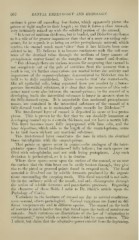Page 592 - My FlipBook
P. 592
G02 DESTAL EMBBYOLOGY AND HISTOLOGY. "
sections it p;ives off exceeding fine thorns, which apparently pierce the
prisms at riglit angles to their length ; so that it forms a close network
very intimately mixed up with the calcified portion of the enamel.
It is not of uniform thickness, but is beaded, and Bodecker attributes
''
to it a role of far greater importance than that of a mere cementing sub-
stance, for he regards it as being an active protoplasmic network which
renders the enamel much more * alive ' than it has liitherto been con-
sidered to be. He believes it to become continuous with the soft con-
tents of the dentinal tubes through the medium of large masses of
protoplasmic matter found at the margins of the enamel and dentine.
" But although there are various reasons for suspecting that enamel is
not completely out of the pale of nutrition from the moment that a
tooth is cut, yet further observations are needed before the activity and
importance of the cement-substance demonstrated by Bodecker can be
held to be fully established. Klein remarks that 'the enamel-cells,
like all epithelial cells, being separated from one another by a homo-
geneous interstitial substance, it is clear that the remains of this sub-
stance must occur also between the enamel-prisms ; in the enamel of a
developing tooth the interstitial substance is larger in amount than in
the fully-formed organ. It is improbable that nucleated ])rotoj)lasmic
masses are contained in the interstitial substance of the enamel of a
fully-formed tooth, as is maintained quite recently by Bodecker.'
The first-formed layer of enamel is deposited in more or less proto-
plasm. This is proven by the fact that we can decalcify immature or
developing enamel u]) to a certain thickness, and yet have a matrix left.
This layer becomes more fully impregnated with lime salts, and the
later deposition, which adds to the length of the enamel-prisms, seems
to be laid down without any matricial substance.
This first-formed layer constitutes the zone in which the dentinal
fibres interdigitate with the enamel-prisms.
That points or spaces occur in enamel—the analogue of the inter-
globular spaces found in dentine—I fully believe ; but such spaces are
filled with calcoglobulin, and not with living protoplasm. Any such
deviation is pathological, as it is in dentine.
AVhere these sj^aces occur upon the surface of the enamel, or so near
the surface that the thin layer can be easily broken through, they give
rise to the pitted or grooved points found in erupted teeth. The fixed
material is dissolved out by soluble ferments produced by the organic
tissue surrounding the erujiting tooth. This fixed material is not solu-
ble in the ordinary acids of the mouth, and only disintegrates through
the action of soluble ferments and putrefactive processes. Regarding
the character of these fluids I refer to Dr. Black's article u^jon the
Pathology of f'aries.
A^ariations in the hardness of enamel are due to several conditions,
some normal, others pathological. Xormal variations are found in dif-
ferent temperaments and in different s])ecies. The enamel on the teeth
of rodents is much harder than that found upon the teeth of carnivorous
animals. Such variations are illustrations of the law of "adaptation to
enviromnont," upon which so much stress is laid bv some writers. This
I admit, but claim that the adaptative power existed from the beginning.


